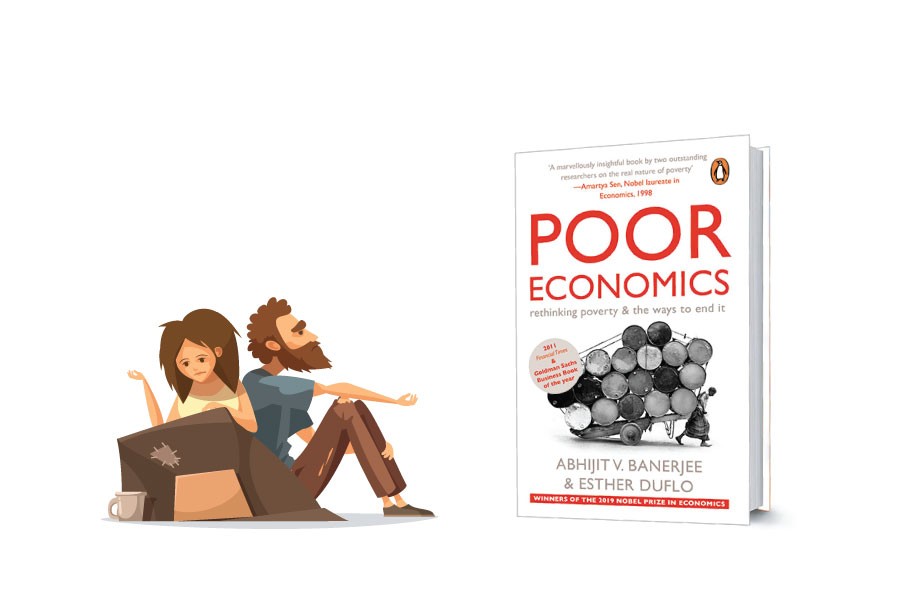In order to understand global poverty better and how people's radical choices worsen the issue, ‘Poor Economics: A Radical Rethinking of The Way To Fight Global Poverty’ by Nobel laureates Esther Duflo and Abhijit V Banerjee is a must-read book.
The book is not a compilation of economic policies intended to solve the unending issue of global poverty, nor is it a list of assumptions required to prove economic theories given by prominent economists.
Rather, it is about reviewing the development policies and traditional tools that are thought to be useful to fight poverty.
“We must arm ourselves with patience and wisdom and listen to the poor what they want. This is the best way to avoid the trap of ignorance, ideology, and inertia on our side”, wrote Abhijit V Banerjee in a section of the book.
Thus, Mr Banerjee is describing the main message of the book, which is the ‘Three Is' problem (ignorance, ideology, and inertia) of poverty trap. It often plagues the efforts which are supposed to alleviate poverty.
The authors of the aforementioned book, winners of the Nobel Memorial Prize in Economic Sciences (2019), have worked with the poor to cull information directly from them in dozens of countries across five continents for more than 15 years.
Abdul Latif Jameel Poverty Action Lab (J-PAL) at MIT pioneered by Duflo and Abhijit has done hundreds of Randomized Control Trials (RCTs) to answer the vital questions about global poverty. The questions include “which aid interventions can be considered as the most effective ones? Why do the businesses of the poor fail despite having the facilities of microcredits? or Why do they choose to spend on expensive medical treatment than on cheap preventions of diseases?
Poor Economics has also uncovered many misconceptions and prejudices of economists, activists, and politicians about poverty trap.
The authors have split the book into two major parts. The first part, focusing on the poor themselves, discusses basically four problems such as hunger, health, education, and population control that are needed to be addressed to alleviate poverty.
And the second part covers the mechanism or institutional framework that may help the poor escape the trap. This portion of the book talks about insurance for the poor, microcredits, unwilling entrepreneurs, worthwhile policies in a corrupt system and so on.
Their analysis found some fascinating, but radical facts and daily decisions of the poor people. For example, why would a poor man in Morocco who has hardly anything to eat and has no source of stable income buy or maintain a television that is expensive and inessential for him? Why do the poorest people in Maharashtra, an Indian state, unnecessarily spend 7.0 per cent of their food budget on sugar? Why do the poor borrow to save? Or why do they pay for unnecessary drugs, but miss out on free life-saving immunisations?
These are some puzzling facts as to why poor people embrace a lifestyle and make choices that can worsen their condition despite having other abilities and options.
Furthermore, have you ever thought how people live on 99 cents per day, which means very limited access to essentials and information? This is the actual complex world that doesn’t get observed in most of the theories and books with simple assumptions.
The poor behave rationally like us or everyone else and even become sophisticated economists to survive the complicated lives in poverty trap, but yet we are as different as liquor and liquorice.
To explain the claims and the actual conditions, Duflo and Abhijit have used the anecdotes and case studies that they have gathered with the help of NGOs and individuals living under the poverty line around the world.
Each chapter has simple graphs and real-life stories shared by real people which are used to describe the further assessments of each study subject.
The authors have concluded in a chapter titled “In place of a sweeping conclusion” where they have jotted down five key lessons emerged from their various studies.
Poor Economics may not be a satisfying read for all readers as it doesn’t offer solutions for all aid or development issues like other development economics books. It offers us a ringside view of the world's poorest people and shows us why it is vital to know the lives and choices of the poor to fight global poverty and why so many magic bullets in the past have failed to solve this issue.
These crucial discussions have made Poor Economics a fascinating read, especially for the readers of Bangladesh as it’s a developing country and the poverty rate is high.
Jinat Jahan Khan is a third-year undergraduate student of economics, Dhaka University. She can be reached at [email protected]


